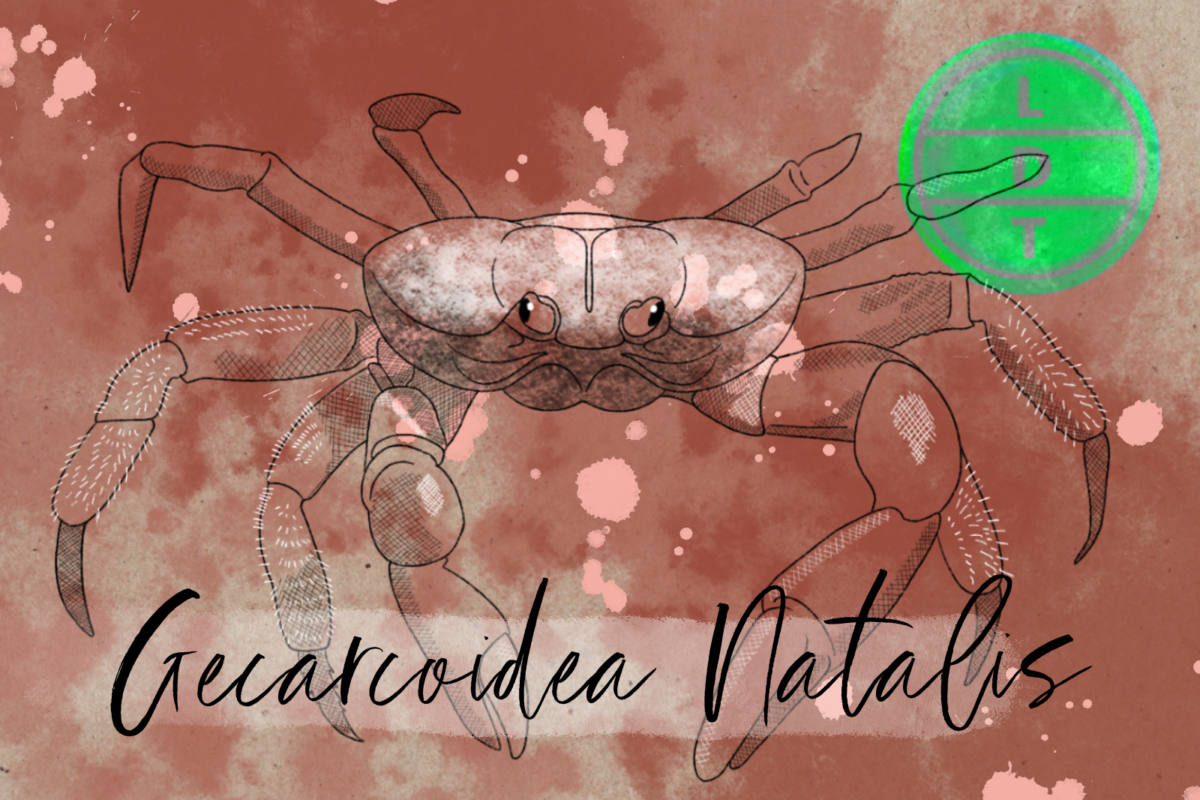“…and today we’ll spend Easter on Christmas Island. Maybe we’ll spend Christmas on Easter Island. Not much more on that later.”
Every year, the festively named Christmas Island takes on one of its holiday hues as millions of its inhabitants make their way to the edge of the briny sea. The Christmas Island Red Crab draws people from all around the world to see one of the largest migrations on the planet. But what exactly prompts these conspicuous crustaceans to get together in the world’s biggest annual Christmas party? It’s all just part of the circle of Life, Death, And Taxonomy.
Description
- Christmas Island crabs are classic looking crabs with rounce carapaces, spidery legs and modest claws.
- They are bright red like a fire truck, and they may have darker red or black coloration in the top of their carapace and the tips of their legs.
- They are tiny when hatched and grow many times their original size.
Measure Up
Welcome to the beloved Measure Up segment. The official listener’s favorite part of the show! The part of the show when we present the animal’s size and dimension in relatable terms through a quiz that’s fun for the whole family. It’s also the part of the show that’s introduced by you when you send in audio of yourself saying, singing, or chittering the words Measure Up into ldtaxonomy at gmail dot com. We don’t have a new Measure Up intro, but we’re going to revisit our greatest hits.
Carapace Length
- 116 millimeters (4.6 in)
- How many crabs go into the length of the longest distance rowed in the Indian Ocean?
- Hint: Erden Eruç, from Turkey, achieved the record between July 13 and April 29, 2011.
- 89,825,885 carbs. He rowed 10,495.28 km (6521.45 miles).
Weight
- 17 ounces
- How many crabs go into the largest barracuda on record?
- Hint: The Barracuda was caught off Christmas Island in 2002.
- 80 crabs. The Barracuda was 38.6 kg (85.1 lb).
Fast Facts
Christmas Island crabs are land crabs, which means they are comfortable skittering around on land. But they do have gills and use them to breathe.
They are also vulnerable to drying out and spend time in burrows to shade themselves from the heat of the sun.
They go into lockdown during the dry season, and cover the entrances to their burrows until the wet season returns, which can take around three months.
Crabs are usually solitary and they will fiercely defend their burrows from intruders.
Red crabs are omnivorous scavengers, but they will mostly eat leaf litter, fruit, flowers, seeds, seedlings, dead animals, trash, and other red crabs. They also enjoy LDT alum the Giant African Land Snail.
They are vulnerable to predation during their larval stage and may be eaten by manta rays and sharks that come to the island for crab breeding season. They are also killed by the invasive yellow crazy ant. They have killed millions in the past few years.
Major Fact: Home for the Holidays
Christmas Island is the stage for one of the largest animal migrations in the world – not in distance, but in numbers.
At the beginning of every rainy season, usually around November, these crabs will leave their homes from around the island and make their way to the seashore to mate and lay their eggs. Their behavior is dictated by the moon. They always spawn at night during a receding high tide in the last quarter of the moon – whenever that is.
They need to stay moist, which is why they wait for the rainy season. Males will show up first, but the females will quickly overwhelm their numbers. All told, an estimated 50-100 million crabs make the 5-mile journey to the coast – it takes about three weeks.
After digging burrows, the crabs will mate and the males will return to their homes inland
The females stay behind with the fertilized eggs – over 100K per crab.
They’ll release the eggs into the ocean, which is risky since they’re land crabs as adults and can’t swim or breathe underwater. The larvae hatch in the water and are swept offshore where they grow into little shrimp things called megalopae and come close to shore. Eventually, they form into baby crabs and crawl onshore.
While most of them are normally eaten during this process, there are some rare years where a massive number will survive and fill the island with little baby crabs.
If the offspring of every female estimated to spawn survived, that would be 2.5 trillion crabs. It doesn’t ever get that high, but it is in the hundreds of millions.
Ultimately, the population stays pretty consistently at about 50-100 million.
The journey for the adults to and from the interior of the island as well as the kiddos on their first journey can be dangerous. There are cars, predators, and even an invasive species of yellow ant that likes to spray acid in their eyes and mouth to kill and eat them.
It’s the main tourist attraction for the island and they have even built little crab bridges over roads and rivers for the adults to climb while they make the journey.
Ending: So follow the moon and the tides, spend some time at the beach, and have more kids because it increases the odds that at least a thousand or so will survive like the Christmas Island Red Crab here in LDT.

